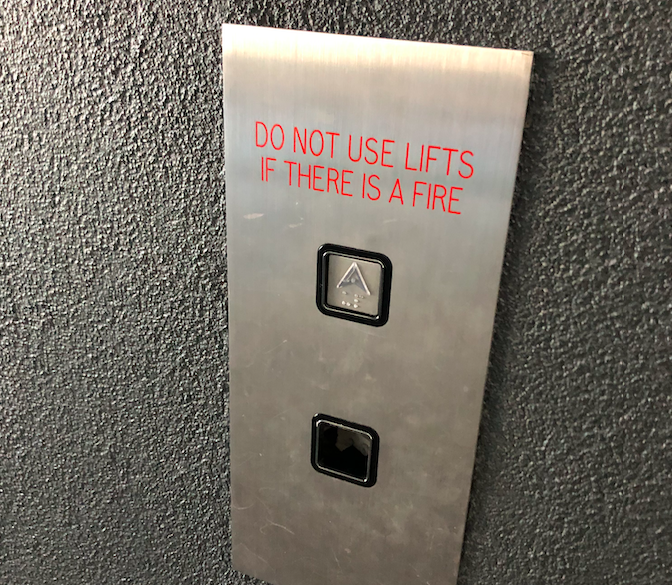|
Issue 10, Semester 2, 2019 EDGAR BOX For most of us, the logic governing the elevators at 185 Pelham Street appears to be the invention of a cabal of half-crazed building planners after being locked away in a basement for two weeks with nothing but a supply of opium and graphing paper. Elevators are selected and dispatched to calls seemingly at random, with no correspondence to the relative proximity between their destination and previous floors. An upward bound elevator accidentally boarded will sometimes suddenly reverse its direction of travel at your request, whilst other times you’ll be dragged the length of the building before it deigns to deposit you at your location. You might wait three minutes in the lobby at 10:30am, whilst a carriage will instantaneously materialise itself for you on level seven at 4:00pm. As law students our lives are already not our own, governed by the operation of a thousand invisible systems, from the cold Boolean preference weighting in timetable allocations, to the inscrutable calculus of aptitude testing in clerkship applications. We cannot control most of these, but we can at least shine a light into some of these hidden corners, including the rules of by which the lifts operate. In all likelihood, you don’t think too often about the lifts, but behind their seeming insanity is actually a hidden dance of mathematics — fascinating once laid bare, and even in its own way, beautiful. All elevator systems at their core must balance two competing goals. The first, trip efficiency, is aimed at minimising the average wait and journey times. The second, starvation avoidance, is aimed at ensuring outlying requests are fulfilled in a timely manner, even when it may be more efficient for the system as a whole to perpetually delay sending a lift for a single passenger request at the top floor to instead service a busy traffic flow on the lower levels. To fulfil these aims, modern elevator systems perform predictions of traffic flow based on probability theory, the time of day, frequency of requests and weight sensors to determine carriage occupancy. Now, the elevators at MLS are manufactured by Thyssenkrupp, a German company that specialises amongst other things in static transport machinery such as escalators and conveyer-belts, and one of the more prominent firms in the world of elevator engineering systems. Although the control systems behind Thyssenkrupp elevators are proprietary, they are likely based off the similar control schemes pioneered by Otis Elevator Company, commercially preferred for their adaptability to the AS.1735.1 requirements of the Australian Council of Standards. As such, we can perform some educated guesswork. In terms of building use, MLS is a more complex system than most commercial offices, apartment buildings, or hotels, possessing a large population distributed inconsistently across ten floors, with relatively continual and complex translocation requirements. Most mid-sized office buildings require one elevator per four floors. The MLS, with ten floors and six elevators possesses one per 1.7.
To service these requirements, the elevators at MLS likely adopt different logics throughout the day. During the morning, particularly clustered around 9:00am and 11:00am when classes start, the system likely adopts an ‘up collective’ model — similar to those used by commercial offices, with the assumption that the majority of journeys will require movement from the lobby upward throughout the building. To accommodate this, most systems will prioritise elevators returning to the ground floor to perform more upward journeys, whilst keeping one or two carriages reserved around the mid-levels of the building to respond to comparatively rarer requests to move between upper floors. Similarly, around lunchtime and toward the end of the day, the system will adopt a ‘down collective’ logic, similar to most hotels, distributing elevators to higher floors to complete long downward runs on the assumption that passengers distributed throughout the building will most frequently want to travel to the lobby. Throughout the remainder of the day, most systems will stagger elevators at different zones throughout the height of the building, calculated by the system based on the number of trips that day and the weights of the carriages, to be able to most efficiently respond to floors where the system predicts the majority of the building’s population is currently located. These models can sometimes lead to seemingly bizarre behaviours. For example, the elevator assigned to levels eight through ten may begin a journey from level eight to the lobby, only for another call to come in at level ten. To avoid that passenger having to wait for the first elevator to complete its journey and return all the way to the top, the system will instead dispatch a carriage from another zone, even a highly demanded one such as the lobby on the assumption that another elevator is likely to soon return to the ground floor. The system designers will consider relative dissatisfaction at wait time — assuming that delaying a dozen people in the lobby by an extra ten seconds is less important than delaying a single passenger at level ten by thirty. Across our degree, each of us will travel the pathways of the elevator roads thousands of times. The choices made for us affect us in ways that are subtle and profound, not just in the time we spend, but the chance companionships and meetings we make on these journeys, with friends, teachers and strangers. We so rarely pay attention to these daily sojourns, but they do form a significant part of our shared lives, a hidden compartment of social interactions and quiet moments that pervade the culture of the law school. And all of this, controlled by an invisible machine mind, shaping the daily experiences of hundreds of people, its influence stretched throughout the height of the entire building. I think there truly is something profound in the thought. It’s an all too rare and often missed pleasure to realise the secret complexity of something that you had always dismissed as mundane. Edgar is the pseudonym of a Second-Year JD Student.
soothed
9/10/2019 11:28:34 pm
this is the most soothing article I never knew I needed.
Lily H
9/10/2019 11:44:16 pm
I’ve said it before and I’ll say it again - MLS lifts are the real world equivalent of the moving staircases
Going up
10/10/2019 06:58:03 am
Well researched and interesting read - De Minimis needs more articles like this. Comments are closed.
|
Archives
October 2022
|



